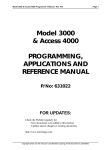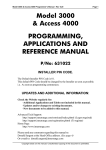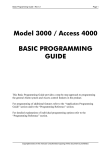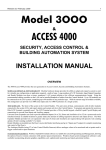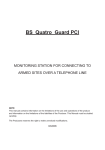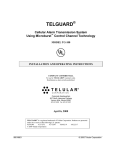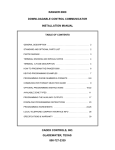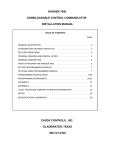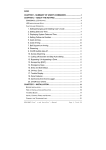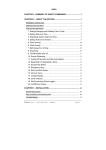Download PM-Comms-19 4+2 - Security Help Desk
Transcript
MODEL 3000 / ACCESS 4000 Programmer’s Manual - Rev 3.00 4+2 Pulse Comms-19-1 “4+2 Pulse” Comms Task Format The 4+2 Pulse format transmits 4 client code and 2 alarm digits to a Central Station using bursts of single frequency. Either 1800Hz or 1900Hz data tones can be used with either 1400Hz or 2300Hz acknowledge tones. Two speeds are available, 20pps or 40pps. Checksum or two round verification may be also specified and Hex compatibility is an option. The two alarm digits used to report events are normally arranged so that the 1st digit represents the type of event (eg. open, close, alarm, restore etc.) and the 2nd digit represents the event detail (eg. user, zone number etc.). The digits allowed are the digits 0 to 9. (0 is actually sent as 10 pulses). If the Central Station can accept Hex digits, the Hex digits A, B, C, D, E, F are also allowed, with “A” being interpreted as “0”. This provides 15 event codes (1st digit) and 15 event details (2nd digit) for a Hex compatible receiver. Programming screens are very similar to those of the Contact ID format, with the addition of 2 extra screens. 4+2 Pulse Options Options are reached by pressing HELP, “9” at the Active / Idle screen. Options are divided into common options and less common or Special options. Usually only the common options need to be programmed. Special options are reached by pressing HELP, “9” twice at the Active / Idle screen. CT001 Client Code: 0000 This screen sets the client code to be used for this Comms Task. The client code is programmable in decimal from 0001 to 9999. (Client codes of 0000 and 9999 should be avoided). If the “Multiple Area Client Code” is set, it is possible for a different client code to be used. CT001 PABX No.-> None These screens allow the installer to define an optional PABX access number. Telephone Numbers are chosen from a pre-programmed list of Telephone Numbers, selected alphabetically by name or by number. See Telephone Number programming. CT001 PABX No.-> TN000 CT001 1st No.-> None These screens allow the installer to define the main Telephone Number to be used to contact the Central Station. Attempts will begin with the 1st number which must be present. CT001 2nd No.-> None If subsequent attempts are needed with different telephone numbers, numbers are tried in the order 2nd, 3rd, 1st and so on. If a number is not present, it is skipped and the next number in the above sequence is tried. Telephone Numbers are chosen from a pre-programmed list of Telephone Numbers, selected alphabetically be name or by number. See Telephone Number Programming. 19. Copyright exists on this manual. Unauthorised copying of this document is prohibited. 4+2 Pulse Comms-19-2 CT001 Dial PpDFTM.6 Options-> nnnnnnnn MODEL 3000 / ACCESS 4000 Programmer’s Manual - Rev 3.00 This screen sets various 4+2 Pulse options: P Pulse Dial (Tel) Selects Pulse (“decadic”) dial when dialling the main Telephone Number. p Pulse Dial (PABX) Selects Pulse (“decadic”) dial when dialling the PABX phone number if present. D Dumb Dialling Selects Dumb dialling. If “n” then Smart dialling is selected (default). See “Attempting Dialer Connections” at the end of this chapter. F Forces 300 Baud Forces all communications to 300 Baud instead of the default 1200 Baud. This need only be set if there are communication difficulties at 1200 Baud. (Relevant to IRfast format only). T Test Mode This enables Test Mode which causes changes to the dial sequence to suit the Victorian Schools Tester. These changes are: -Do not dial the Telephone Number -Do not wait for initial handshake -Do not require an acknowledgement -Shorten inter-round time from 500ms to 300ms M Maximum Count This enables the Maximum Count option. This option allows the maximum call time in 4+2 Pulse to be based on valid acknowledgements received, rather than time. If this option is set, the maximum call time is based upon the number of packets sent (1 to 255) programmed in the “Online Time” screen, under Special Options. . Spare This option has been left spare for future development. 6 60 sec Redial This option forces the Comms Task to wait 60 seconds between any redial attempt. This option must be set to comply with Singapore Telecom regulations. CT001 MLGPN... Ropts -> nnnnnnnn This screen sets various reporting options: M Multiple Area Codes If Multiple Area client codes are selected, whenever a report from an Area is performed (open/close/alarms/tampers/isolations/restores) the client code defined in Area Programming will be used if it is not “0000”. If the Area Client code is “0000”, the Comms Task client code will be used. If this option is set to “n” then the Comms Task client code will always be used. (See Area Programming for more details of this application) L Look Ahead Normally all reportable events will be sent in the order that they occur; one at a time until no more reports are required. The Comms Task will ensure the order will not alter, even if the dialer takes a long time to get through to the Central Station or if reports are being generated faster than they can be sent. If this option is set to “Y”, Look Ahead operation is selected. With Look Ahead selected, a sequence of multi-breaks on a single Zone/Input will be ignored if a restore report has already been sent for that Zone/Input and there are new alarms from a different Zone/Input that have not been sent yet. Open/Close reports do not follow this logic and are always reported. This option is useful to track intruder movement through a larger installation and ignore multi-breaking detectors. Copyright exists on this manual. Unauthorised copying of this document is prohibited. MODEL 3000 / ACCESS 4000 Programmer’s Manual - Rev 3.00 G General O/C 4+2 Pulse Comms-19-3 This option selects general open and close reporting. Whenever all Areas are turned ON a general Area close is reported. As soon as the first Area is turned OFF, a general Area open is reported. In Area programming, some Areas can be nominated as “Not General Area” and are ignored in the general Area calculation. Open/Close will not be reported on these Areas in any Comms Task with this “General Open/Close” option set to YES. Another Comms Task with this option set to NO may be used to allow these Areas to trigger individual Open/Close reports. See Area Programming “Not General Area” option for details. P Prevents Restores This option prevents restores being reported via this Comms Task. N No Area Still Open In Area programming, it is possible to enable reporting of “Area Still Open” and “Area 24Hour Offs”. Not all reporting formats can handle these reports. Setting this option to “Y” will disable these reports for this Comms Task. Both of these reports are sent without any loss of information in IRfast format. CT001 Area List Filter: AL002 This screen allows an optional Area List filter to be defined for this Comms Task. If a non-zero Area List is chosen, only information from Areas in the specified Area List will be sent using this Comms Task. CT001 EOA..... Efilt-> nnnnnnnn The “Extra Filter” screen option allows a Comms Task to only respond to certain types of events. E Extra Filter This option enables Extra Filter options. If left at “n”, no extra filtering is used. ie. normal operation. O Opens/Closes This option enables Opens/Closes reports to be sent via this Comms Task. A Alarms This option allows Alarms/Tampers/Isolations to be sent via this Comms Task. . Spare Spare options for future filters. Leave set to “n”. 4+2 Pulse - Specific Options These options are reached by pressing HELP, “9” twice at the Active/Idle screen, or by pressing HELP, “9” from any common options screen. HELP, “0” will take you back to the common options when programming of special options is complete. CT001 Open/Close Codes: 00 This screen allows the 1st alarm digit to be defined for opening events and separately for closing events. On the programming screen the 1st digit is the one that will be used for openings and the 2nd digit is the one that will be used for closings. For example, if this screen is set to “56”, openings will be reported as “5X” and closings as “6X”, where “X” represents the event detail which, in this case, means the User who turned on/off the area. See the section on mapping at the end of this section. CT001 214HC..B Format->nnnnnnnn This screen allows the Installer to set some miscellaneous options. These options allow the Comms Task to be configured for compatibility with most proprietary pulse formats. 19. Copyright exists on this manual. Unauthorised copying of this document is prohibited. 4+2 Pulse Comms-19-4 MODEL 3000 / ACCESS 4000 Programmer’s Manual - Rev 3.00 NOTE: The fastest operation is achieved at 40pps with Checksum verification. More unique events can be sent with a hex compatible format. 2 2300Hz Ack Tones Normally 1400Hz acknowledge tones are used. This option allows 2300Hz acknowledge tones to be used instead. 1 1900Hz Data Tones Normally 1800Hz data tones are used. This option allows 1900Hz data tones to be used. 4 40 Pps Normally the reporting speed is 20 pulses per second. This option allows 40 pulses per second to be used. H Hex Compatible All pulse formats can use the digits 0 to 9. Selecting this option allows the Hex digits A, B, C, D, E, F to also be used. (“A” is the same as “0”) C Checksum Normally the event is sent twice for dual round verification. This option allows a single checksum digit to be sent for verification. . Spare Spare for future development. Leave set to “n”. B Backup Task Setting this option causes this Comms Task to act as a backup Comms Task to another task. 4+2 Pulse - Special Options Special options are reached by pressing HELP, “9” three times at the Active/Idle screen, by pressing HELP, “9” twice from any common options screen or pressing HELP, “9” from any specific options screen . Pressing HELP, “0” will take you back to the specific options and pressing HELP “0” twice will take you back to the common options screen when programming of special options is complete. CT001 Maximum Attempts: 000 This screen sets the maximum dial attempts this task will use to attempt to contact the Central Station. If left at zero then the default of 8 attempts will be used. Telecommunication regulatory authorities may limit this number. (In Australia, Austel specify a maximum of 10 attempts). CT001 Backup Attempts: 000 This screen sets the number of dial attempts before the backup input will be triggered (C01:S20). If left at 000 the default value of 4 will be used. CT001 Backup Task: CT000 This screen allows an optional backup task to be specified that will be triggered if this Comms Task fails to communicate within its maximum attempts. Leaving the task at CT000 specifies no backup task will be triggered. CT001 Seize Aux C01:X08 This screen allows an Auxiliary output to be specified. This Auxiliary will turn on whenever the dialer line is seized and will turn off whenever the dialer line is released. CT001 Pass Aux C01:X08 This screen allows the installer to specify an Auxiliary output to turn on whenever the dialer successfully sends a report to the Central Station. It must be turned off by some other mechanism such as a timer. Copyright exists on this manual. Unauthorised copying of this document is prohibited. MODEL 3000 / ACCESS 4000 Programmer’s Manual - Rev 3.00 4+2 Pulse Comms-19-5 CT001 PABX Dial Wait: 000/10 sec This screen sets the time the task will wait to sense dial-tone before dialling the PABX number. The time is programmable from 1/10 sec to 255/10 sec (25.5 seconds). If this option is left at 000/10 then the default time of 3 seconds will be used. CT001 Main Dial Wait: 000/10 sec This screen sets the time the task will wait to sense dial-tone before dialling the Main number. The time is programmable from 1/10 sec to 255/10 sec (25.5 seconds). If this option is left at 000/10 then the default time of 3 seconds will be used. CT001 Handshake Wait: 000 This screen sets the time the task will wait for an initial handshake after dialling the Central Station. The time is programmable from 1 second to 255 seconds. If this option is left at 000 then the default time of 30 seconds will be used. CT001 Max.Online Time: 000 min This screen sets the maximum time the task will stay on-line before hanging up and re-dialling. The time is programmable from 1 minute to 255 minutes. If this option is left at 000 then the default time of 10 minutes will be used. CT001 Line Test Count: 000 This screen sets the parameters associated with line testing and should be left at 000 unless advised by the manufacturer. Introduction to Dialer Formats When activated, a Comms Task set to a Dialer format (Contact ID, IRfast, or SIA) will continually look for any reports to be sent. When a reportable event is found, the dialer line will be used to attempt a connection to the Central Station. If the dialer line is being used, the attempt will be deferred until whatever is using the dialer line is finished. When finished, this Comms Task will “take-over” the dialer line and will not release it until it is finished. The connection attempt works in one of two ways: M Smart Dial This is the default setting. The task will monitor the line for line faults, dial-tone, busy etc. and make dialling decisions based on results of attempts to connect to the Central Station as quickly as possible. All activity will be recorded to review. M Dumb Dial This setting does not make “smart” decisions based on sensed tones, although all tones sensed and dialer progress are recorded to review. The operation of these two modes is described in more detail in the section headed “Attempting Dialer Connection”. Once connected, the task will report all alarms until either there are no more alarms, or the on-line timer expires (default is 10 minutes). Alternatively, if the “Look Ahead” option is set, old alarms will be skipped in favour of new alarms. Attempting Dialer Connections Most Comms Tasks formats which need to dial a number to report information follow the logic below. Either smart dial or dumb dial can be selected on a per Comms Task basis. 19. Copyright exists on this manual. Unauthorised copying of this document is prohibited. 4+2 Pulse Comms-19-6 MODEL 3000 / ACCESS 4000 Programmer’s Manual - Rev 3.00 Smart Dial 1. Seize Line and wait 3 seconds to see if phone is ringing. If phone is ringing wait till it stops ringing. 2. Test Line for DC voltage. If no line then unloop line, wait variable time then try again to same Telephone Number up to maximum attempts. 3. If got PABX number then loop line and wait for dial tone. If get dial tone then begin dialling. If get busy then unloop line, wait variable time then try again up to maximum attempts. If don’t get dial tone then dial PABX number anyway. 4. Now wait for main dial tone. If get dial tone then begin dialling. If get busy or don’t decode dial-tone then unloop line, wait variable time then try again to same Telephone Number up to maximum attempts. 5. Wait for Central Station required handshake for this format. If get dial tone or busy then unloop line, wait variable time then try again to a newTelephone Number up to maximum attempts. If get time out then unloop line, wait variable time then try again to a new Telephone Number up to maximum attempts. If get required handshake then start on-line timer. 6. Proceed with communications for this format. If redial is required due to errors then unloop line, wait minimum time then try again to the same Telephone Number up to maximum attempts. Dumb Dial 1. Seize Line and wait 3 seconds to see if phone is ringing. If phone is ringing wait until it stops ringing. 2. Test Line for DC voltage. If no line, save review message and continue. 3. If got PABX number then loop line and wait for dial tone. If get dial tone, begin dialling. If get busy, save review message and continue. If do not get dial tone, dial PABX number anyway. 4. Wait for main dial tone. If get dial tone, begin dialling. If get time-out or any other tone, save to review and continue. 5. Wait for Central Station required handshake for this format. If get timeout, unloop line, wait variable time then try again to a new Telephone Number up to maximum attempts. If get required handshake, start online timer. 6. Proceed with communications for this format. If redial is required due to errors, unloop line, wait minimum time then try again to the same Telephone Number up to maximum attempts. NOTE: Many telephone lines in Australia and New Zealand have a Message Bank or similar service connected. The differential dial tones used as indicators for such services can impede communication by the panel. Copyright exists on this manual. Unauthorised copying of this document is prohibited. 4+2 Pulse Comms-19-7 MODEL 3000 / ACCESS 4000 Programmer’s Manual - Rev 3.00 To avoid possible communication problems either disable the connected service or set the (D)umb Dialling option in Comms Task Programming. Mapping A flexible mapping scheme has been devised. The 3000/4000 system follows the basic philosophy of the 1st digit representing the type of event and the 2nd digit representing the event detail. Before selecting which digits to use for reports, the Installer must decide which reports will be sent. The Installer must ensure that, if a particular event type has not been catered for, the panel cannot generate an Xmit entry for this event type, thereby causing the wrong digit to be used in the report. The client code is determined by Comms Task programming. However, if an Area Client Code is defined, it will be used instead. Openings and Closings The 1st digit for openings and closings is programmed in the Open/Close Codes screen. The 2nd digit represents the User or operation that operated the Area. Entity that operated the Area 2nd Digit in non Hex mode 2nd Digit in Hex mode * User manual open/close Power on arm TimeZone Function Zone IRfast Command Calculated Auxiliary Unidentified User CommPass Command DTMF Command Timed On Last digit of User code 0 0 0 0 0 0 0 0 0 Last digit of User code B C D F E B F F B * Requires Hex option to be set on option screen. Alarms, Tampers, Isolates and Restores The two report digits to be used for any particular event are determined from the “base” digits. The “base” digits are defined by the “4+2 Pulse Msg” option in the Process Group used to generate the Xmit entry. For example, if the Process Group “BURGLARY” has the 4+2 pulse message set to “28”, then the “base” digits for any event with the Process Group “BURGLARY” will be “28”. For zones that have a programmable text description, the “base” digits determined by the Process Group can be optionally overridden by “base” digits programmed as part of the Zone description for that Zone only. If the text description contains a string in the form “<XY>” where XY are two Hex digits, then XY become the “base” digits for all events in this Zone. 19. Copyright exists on this manual. Unauthorised copying of this document is prohibited. 4+2 Pulse Comms-19-8 MODEL 3000 / ACCESS 4000 Programmer’s Manual - Rev 3.00 For system alarms which have fixed text description, the “base” digits are always defined from the Process Group. Having determined what the “base” digits are, the actual report digits to be used are determined by the type of event. The table below explains: Event with “base” digits “XY” 1st Report Digit Alarm Restore Tamper Isolate X X+1 X+2 X+3 2nd Report Digit Y Y Y Y For example, if the “base” digits were “28” : • • • • Alarms reported as “28” Restores reported as “38” Tampers reported as “48” Isolates reported as “58” Further Considerations Having determined whether or not the format will use Hex digits (Hex gives greater flexibility), the programmer needs to decide which events are to be reported. For example, if a Process Group is programmed to send alarms, restores, tampers and isolates, 4 pairs of digits need be set aside for reports from that Process Group.( As per the previous table these would be 28, 38, 48 & 58.) Care must be taken to ensure that no other reports can inadvertently use the same digits. If only alarms are to be reported, then ensure that: • • Process Group options are not programmed to send isolates, tampers or restores. The Comms Task has the (P)revent restore option set. If no openings/closings are to be reported, ensure that: • Area open/close report options are set to no. NOTE: You cannot send; • • An isolate without also mapping tampers and restores A tamper without also mapping a restore By allowing individual Zones to have their own unique “base” digits, Zones can conveniently define unique 2nd digits when required. System Inputs are not quite as flexible, requiring different process groups if different 2nd digits are required for different system alarms. Copyright exists on this manual. Unauthorised copying of this document is prohibited.









